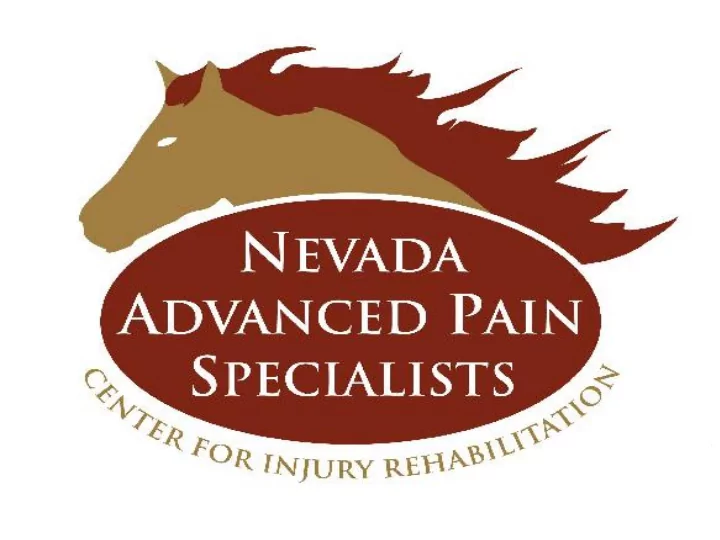

Opioids: What You Should Know About Opioid Prescribing Denis G. Patterson, DO Nevada State Medical Association October 19, 2016
Contact Information Denis G. Patterson, DO Nevada Advanced Pain Specialists www.nvadvancedpain.com patterson@nvadvancedpain.com
Prevalence of Pain • Unrelieved pain is recognized as a significant health problem in the United States • 100 million Americans suffer from chronic pain • Less than 40% of people with severe chronic non-cancer pain reported that their pain was under control
Changes in Pain Treatment Paradigms • 1986 Portenoy and Foley published a seminal paper • 1995 American Pain Society set guidelines for treating pain • 1997 FDA allows direct-to-consumer marketing • 1999 the VA Department launched a campaign known as “Pain is the Fifth Vital Sign” • Joint Commission endorsed the VA campaign • Subspecialty of Pain Management is born
Changes in Pain Treatment Paradigms Outcome
Statistics • 20% of patients who present to a physicians office for pain receive an opioid prescription • In 2012, 259 million prescriptions for opioid pain medications were written in the United States
The Dark Side • Since 1999, 140,000 people have died from an overdose related to opioid pain medication in the US • More than 16,000 deaths occurred in 2013, four times the number of overdose deaths related to these drugs in 1999
Unintentional Opiate Overdose Deaths Parallel Opioid Sales in United States, 1997 – 2007 • Overdose deaths – 2,901 in 1999 – 11,499 in 2007 • Distribution by drug companies – 96 mg/person in 1997 – 698 mg/person in 2007 Source: National Vital Statistics multiple cause of death data set and Drug Enforcement Agency ARCOS System
Prescription Drug Misuse and Abuse: Hype or an American Epidemic?
Time for Change • March of 2016, The CDC published it’s Guideline for Prescribing Opioids for Chronic Pain
Target Audience • Opioid prescribing rates have increased more for family practice, general practice, and internal medicine compared to other specialties from 2007 - 2012 • Presciptions by PCP’s account for nearly half of all dispensed opioid prescriptions
Guideline Goals • Provide recommendations for primary care providers who are prescribing opioids for chronic pain outside of active cancer treatment, palliative care, and end-of-life care
Recommendations • Grouped into 3 areas of consideration: 1. Determining when to initiate or continue opioids for chronic pain 2. Opioid selection, dosage, duration, follow up and discontinuation 3. Assessing risk and addressing harms of opioid use
Twelve Step Opioid Protocol • Step 1 - Assessment of Pain (VAS 0 -10)
Twelve Step Opioid Protocol • Step 2 - Clear documentation of rationale for opioid use (i.e. chronic pain)
Twelve Step Opioid Protocol • Step 3 - Clear documentation of beneficial clinical response to opioid use (i.e. decrease in pain)
Twelve Step Opioid Protocol • Step 4 - Establish goals of opioid treatment and review of goals (i.e. patient wants to increase function)
Twelve Step Opioid Protocol • Step 5 - Current and updated medication list
Twelve Step Opioid Protocol • Step 6 - Documentation of substance abuse (i.e. patient denies an history of prescription drug abuse issues)
Twelve Step Opioid Protocol • Step 7 - Physical examination of painful area
Twelve Step Opioid Protocol • Step 8 - Documentation of risks and benefits (risks explained to patient)
Twelve Step Opioid Protocol • Step 9 - Appropriate referral for additional evaluation and treatment
Twelve Step Opioid Protocol • Step 10 - Updated Board of Pharmacy review
Twelve Step Opioid Protocol • Step 11 - Current and consistent UDS within the last 30 days
Twelve Step Opioid Protocol • Step 12 - Patient has signed and Opioid Agreement with the last 6 months
Strategies for High Dose Opioids Patients • Educate patients on CDC recommendations • Get behavioral health involved • Determine what they are “actually” on • Use Opioid Calculators to determine Morphine Equivalent dose • Wean slowly to recommended levels • Utilize Opioid Rotations
Strategies for High Dose Opioids Patients • Eliminate Benzodiazepines • Access PMP reports • Utilize urine drugs screens • Consider using pill counts for problematic patients • Get them involved in “active treatments”
Bottom Line • As a provider, you have no legal, ethical, or moral obligation to accept or treat these patients • Be upfront with them and let them know what your expectations and treatment plans are
Bottom Line • If the patient is unwilling to accept your plan and expectations, it is better to part ways from the start
Questions
Discussion
Nevada Advanced Pain Specialists Opioid Approach
Nevada Advanced Pain Specialists Opioid Approach • Medication Agreement • Sent out before the appointment • Sets the “rules” before there can problems
Nevada Advanced Pain Specialists Opioid Approach • Urine Drug screens • Always done at first appointment • Done randomly and when issues arise or changes occur
Nevada Advanced Pain Specialists Opioid Approach • Utilize the Nevada Task Force Inquiry • Risk stratification done for every new patient seen
Nevada Advanced Pain Specialists Opioid Approach • Only prescribe medications you feel comfortable with • I personally avoid Methadone, Soma, the D’s and Benzodiazepines
Nevada Advanced Pain Specialists Opioid Approach • Try to manage pain with as little medication as possible • This includes the number of medications and the number of pills
Nevada Advanced Pain Specialists Opioid Approach • Consistency • Consistency • Consistency
Recommend
More recommend